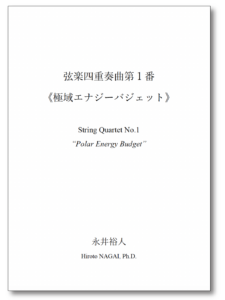Basic info.
Composer: Hiroto NAGAI
Composed year: 2022
Original performance: PRT Quartet
Time: 6 min.
Original performance
Note
The materials for this work are originated from satellite-based earth observation data and climatic reanalysis datasets. They quantify the temporal changes of multiple physical quantities (i.e. shortwave and longwave radiation, surface temperature, cloud optical thickness, and precipitation). Four polar-regional points (i.e. an ice-core drilling site in the Greenland ice sheet, satellite communication facilities at Svalbard Islands, Showa Station in Antarctica, and Dome Fuji Station in Antarctica) are set for data sampling for two violins, a viola, and a cello. The composer’s artificiality is added very little in the introduction chapter, whereas it appears more intensively in the latter chapter of the piece.
In meteorology and other earth science, we know that almost all atmospheric phenomena and ecosystem are fundamentally driven by the solar radiant energy. The solar energy transmitted in different forms causes the balance and order on the terrestrial surface, resulting in human’s civilization. Not only focusing on outreach against the global warming, but the composer here intends to express great possibilities to tell about numerous aspects of earth science with artistic expression supported by the sonification technique.
本作品の素材は人工衛星などによる地球観測データについて、北極・南極周辺にある4地点の各種物理量の時間変化を数値化したものである。具体的には、短波および長波放射・地表面温度・雲による日射減衰率・降水量である。四重奏の高音パートから順に、グリーンランド氷床上・スバールバル諸島・南極昭和基地・南極ドームふじ基地の各地点が割り当てられ、楽曲後半になるほど作曲者の作為性が介入している。
気象学や地球科学では、ほぼ全ての気象現象やエコシステムが太陽の放射エネルギーを根源として成り立っていることを学ぶ。太陽からのエネルギーが形を変えながら伝わっていき、地球表層上のバランスと秩序、そして我々人間自身の営みを作り出している様を念頭に、音を編み込んでいった。「地球温暖化の警鐘を鳴らす」や「環境保護の重要性を訴える」という安直なテーマに限定せず、芸術表現としての可能性を広げることを重視する。
Compositional commentary
Score

Acknowledgement
This musical composition and performance were carried out in a research project financially supported by the Remote Sensing Technology Center of Japan. A climatic reanalysis dataset, ERA5, provided by the Copernicus Climate Change Service and MODIS datasets provided by Land Processes Distributed Active Archive Center (LP DAAC), NASA were imported for composition. Those contributions are greatly appreciated.
